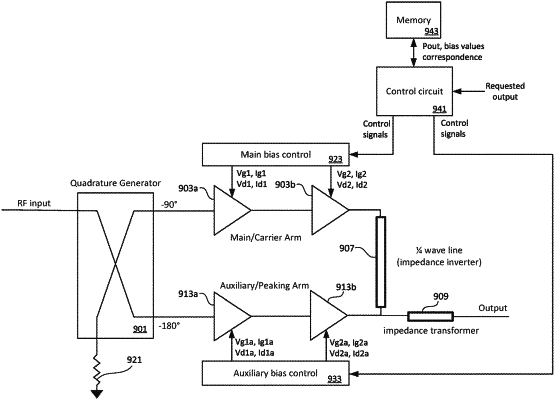| CPC H04B 7/18515 (2013.01) [H01Q 1/288 (2013.01); H03F 1/0288 (2013.01); H03F 3/195 (2013.01); H03F 3/245 (2013.01); H04B 1/04 (2013.01); H04B 1/0458 (2013.01); H04B 1/0483 (2013.01); H04B 1/18 (2013.01); H03F 2200/451 (2013.01); H04B 2001/045 (2013.01)] | 14 Claims |

|
1. A method, comprising:
receiving an input signal at an input splitter of a solid state amplifier;
receiving the input signal from the input splitter at a main arm of the solid state amplifier, the main arm including a first main amplifier stage;
biasing, by a first bias control circuit of the solid state amplifier, the first main amplifier stage according to a corresponding first set of control signals;
generating a first output signal from the input signal by the first main amplifier stage biased according to the corresponding first set of control signals;
receiving the input signal from the input splitter at an auxiliary arm of the solid state amplifier connected in parallel with the main arm, the auxiliary arm including a first auxiliary amplifier stage;
biasing, by a second bias control circuit of the solid state amplifier, the first auxiliary amplifier stage according to a corresponding second set of control signals;
generating a second output signal from the input signal by the first auxiliary amplifier stage biased according to the corresponding second set of control signals;
receiving, at a combining circuit of the solid state amplifier, the first output signal and the second output signal;
generating by the combining circuit a combined output signal for the solid state amplifier from the first output signal and the second output signal; and
generating the corresponding first set of control signals and the corresponding second sets of control signals by a control circuit of the solid state amplifier, the corresponding first set of controls signals configured to generate the first output signal to have a specified response over a first output range when the input signal has an amplitude below the threshold level, and the corresponding second set of control signals configured relative to the corresponding first set of control signals to generate the combined output signal to have the specified response over a second output range when the input signal has an amplitude above a threshold level.
|